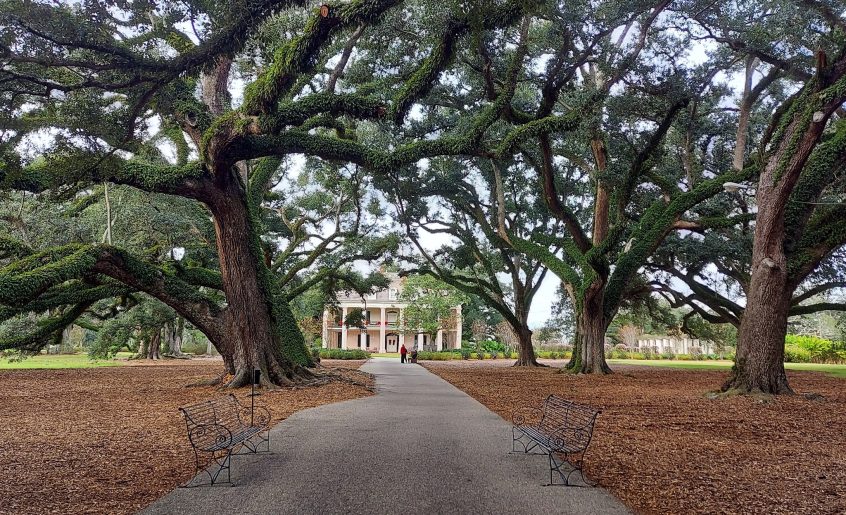Yesterday was all about plantations along the Mississippi river. I woke up in a cottage on the property of Destrehan Plantation. Should you ever want to stay in this area, it’s a great place. Far larger than my apartment, the cabin is elegant and comfortably furnished, with an enormous living room, kitchen, comfortable bedroom and two bathrooms.
A benefit of staying there is that I woke up within steps of the plantation. I spent a couple of hours on the grounds, including a personal tour of the great house. I learned about the building technique used, called bousillage, that incorporated post and beam construction with a clay and Spanish moss mixture. I also learned how they burned oyster shells to gather the lime necessary for making plaster. I was fascinated by the demonstration and explanation.
Another interesting fact I learned (that was certainly never part of my American history classes) was the compromise that allowed Louisiana to become, in 1812, the 18th state—it was allowed to maintain French as its official language.
Nearly 40 years ago I spent a lot of time visiting with a friend who was living in Metairie (a close-in suburb of NOLA). She took me to see several plantation homes. What was presented then emphasized the plantation owners and their lives, only mentioning enslaved workers in passing. It was as if the plantations planted sugarcane, ran the household, and did all the other tedious chores with the willing participation of workers.
Now, the stories are more realistic, giving equal weight to slave owners and enslaved people. It’s chilling to see lists of people with prices attached to them, treated as if they were commodities rather than humans. Displays of shackles and other devices used to punish and/or subdue resistance made my skin crawl. The slaves’ miserable living conditions, especially in contrast to the conditions in the big house, are a vivid illustration of the horror of slavery.
At Destrehan there is an exhibit about an uprising that took place there and at other nearby plantations in 1811. The docent pointed out that information about rebellions is rare. Plantation owners didn’t want to publicize this kind of news, so after rebellions were squelched news of them evaporated. Unwanted behavior wasn’t documented anywhere, lest anyone get ideas. In both plantations I visited docents lead talks about life as an enslaved person.
From Destrehan, I drove about 30 miles, crossing the Mississippi River and paralleling the levee, to visit Oak Alley Plantation Restaurant & Inn & Gift Shop. The ride is along flat land that to this day remains mostly sugarcane fields—the main crop of riverside plantations in this area. Driving along there is no way to see the river because the levee blocks the view. But peeking over the levee I could see the towers and lights of the petroleum refineries and chemical companies that border the river. While they perform a necessary task, they are the worst polluters of both water and air in Louisiana.
Oak Alley is a physically beautiful location (in Vacherie, Louisiana). It takes its name from the 28 live oak trees that form an alley (or allee in French). I took so many photos of the trees, with intense green Spanish moss and epiphyte plants attached to them, you’d have thought there was nothing else to see. But there is a lot more to see and learn, including information about the enslaved people who worked there as well as the history of the plantation and its owners.
At its largest the plantation was about 1,200 acres; 25 acres remain. On the property there are gardens, a slew of exhibits about life on the plantation, a gift shop, and cottages for overnight stays.
I ate a fabulous lunch at the restaurant on the grounds—red beans with smoked sausage, crawfish etouffée, steamed white rice, and a cup of chicken gumbo. Yum! For dessert I had to try the buttermilk pie. Heavily spiced with cinnamon, it was creamy and surprisingly light.
Many thanks to Destrehan and Oak Alley Plantations for their hospitality.

